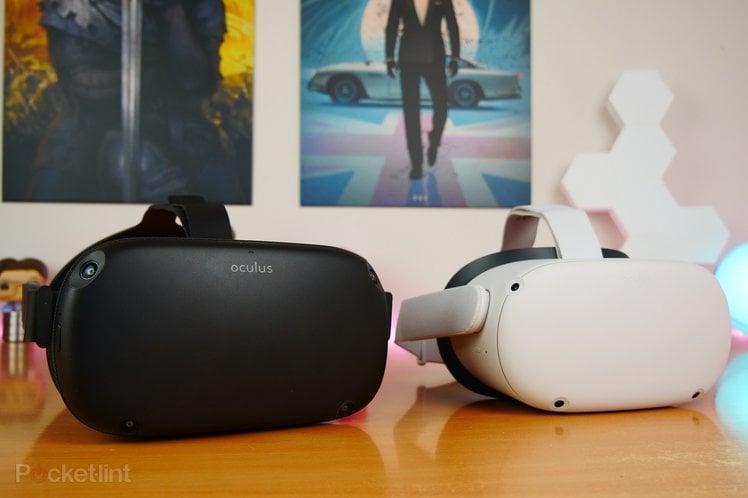
The Oculus Quest 2 is an updated version of Oculus’ wireless virtual reality headset, but what makes it different to the original?
Well, there are a number of both aesthetic and technical changes that make the Quest 2 worth considering. It might well be a brilliant purchase for those looking to get into VR or a potential upgrade option for current Quest owners. Read on to find on what’s different.
Design
- Oculus Quest – manual IPD slider, black cloth design, rubber headstrap
- Oculus Quest 2 – new white finish, cloth/material straps with updated tightening system, flip-up visor, three IPD levels
The original Oculus Quest was one of our favourite VR headsets, with an excellent lightweight design and surprisingly capable hardware making it a viable alternative to much more expensive PC VR headsets. Without the need for an accompanying gaming PC or laptop, it made a lot of sense to buy and now has been improved upon in the Quest 2.
Quest 2 stands out from the original thanks to a bold white design versus the original black and grey theme. It features much more than a colour change though.
The Quest 2 has a new head strap design which makes it easier to adjust and offers a more comfortable fit. It’s also designed to be more accessible and easier to use too.
Where the original Quest had a manual IPD slider, the Quest 2 now has a system which lets you move the lenses into three different preset positions – 58mm (setting 1), 63mm (setting 2) and 68mm (setting 3). Oculus says this design is intended to be simplified and that most users will find one of the three settings is perfect for them, removing the hassle of measuring your IPD and adjusting the levels in a granular manner.
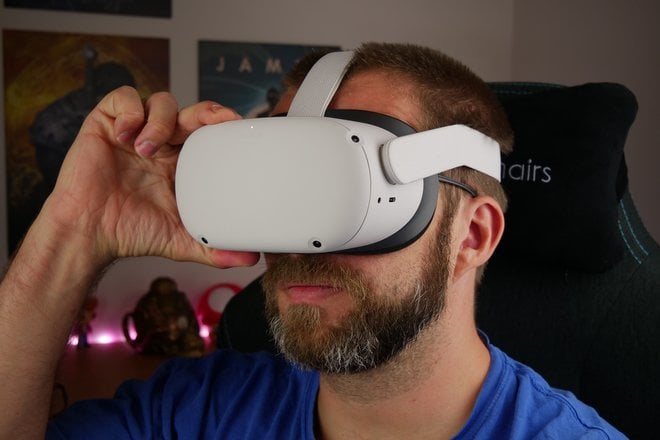
Quest 2 has changed in other ways too. It’s 10 per cent lighter than the Quest (just 503g) and features a new and improved faceplate design that appears to let less light in while you’re gaming, resulting in a much more immersive experience. The visor also now has the ability to be flipped up slightly out of the way if you need to look at the world around you without taking the headset off.
Both the Quest and Quest 2 sport some impressive integrated, rear-firing speakers built into the strap and deliver the sound right into your ears without the fuss of extra wires from the headphones. The Quest 2 offers nifty positional audio and both headsets also have microphones to capture your voice for multiplayer experiences.
These speakers do lead to a little bit of sound bleed though, so if you need a more private experience then you’ll be pleased to hear there’s the option to use a 3.5mm headset or headphones instead.
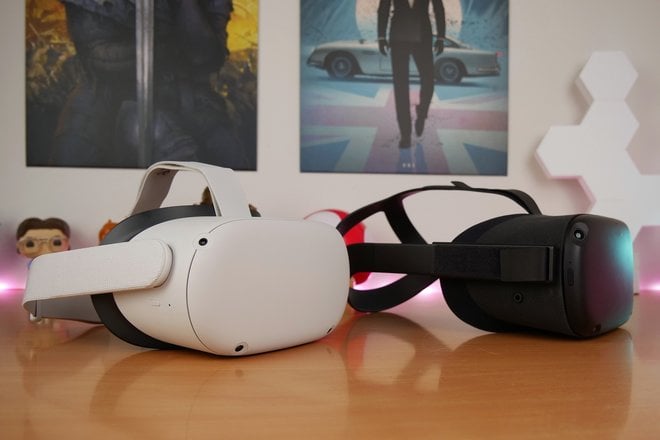
Specification changes
- Oculus Quest – Qualcomm Snapdragon 835, Qualcomm Adreno 540 GPU, 4GB RAM, 64GB/128GB internal storage
- Oculus Quest 2 – Qualcomm SnapdragonTM XR2 Platform, 6GB RAM, 64GB/256GB internal storage
Alongside the various aesthetic and comfort changes, the Oculus Quest 2 has been given a boost in power and specs versus the original VR headset.
Quest 2 uses the latest and greatest Qualcomm system, with 50 per cent more RAM designed to help power the improved visuals and give game developers more power to play with.
The entry-level version of each headset has 64GB of internal storage for your games, but now Oculus has added significantly more storage with the Quest 2 also available with a 256GB option. The price has come down too, with that more storage-rich version costing the same as the smallest version of the original Quest.
The extra power in the Quest 2 will hopefully give developers more freedom when developing games, while also enabling users to get even more enjoyment out of Oculus Link as well.
Both Oculus Quest and Quest 2 offer hand-tracking capabilities. This has been an experimental option with the Quest for some time, but is shipping as standard in the Quest 2.
Oculus Link has also come out of beta and is more readily available with Quest 2. Meaning it’s much much easier to connect it to your PC and play PC VR games from the Oculus store or via Steam if you so wish.
The Quest 2 also supports a 90Hz refresh rate (and 120Hz in some cases), as well as other clever things like calorie tracking too.
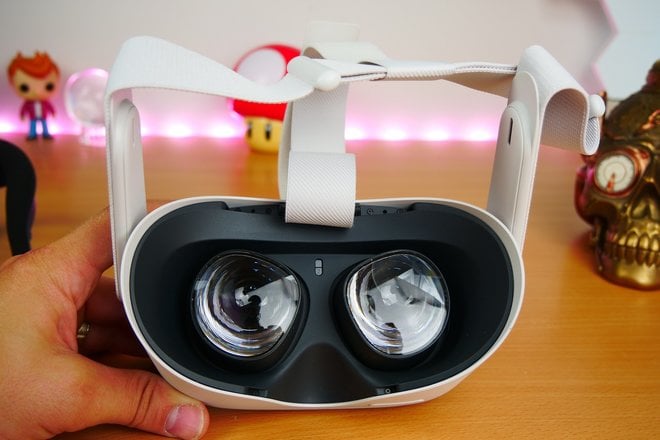
Visuals
- Oculus Quest – OLED display with 72Hz refresh rate and 1600 x 1440 pixels per eye
- Oculus Quest 2 – Fast-switch LCD panel with 1832 x 1920 per eye 72Hz at launch; 90Hz support to come
Alongside the extra power under the hood, the Oculus Quest 2 has also been improved in the display department. The headset now offers 50 per cent more pixels than Quest. That’s close to 2K resolution per eye and it also comes with the promise of a faster refresh rate, which leads to a smoother and more enjoyable experience.
Where the Oculus Quest managed 72Hz refresh rate, the Oculus Quest 2 is apparently capable of 120Hz.
The 90Hz refresh rate option was rolled out a while back and needs developers to unlock it for their games in order to work, but it does mean the promise of better experiences alongside improved visuals thanks to the extra pixel count.
The Quest 2 continues to offer the Passthrough+ view which allows you to see the world around you using the inside-out tracking cameras and the intelligent guardian boundary play space system. This was available on the first Quest and is just as good on the newer device, making it easy to re-orient yourself or see the real-world without having to take the headset off.
This is nicely designed so you can simply double-tap on the side of the headset to activate it. This means you can quickly and fairly clearly see the world around you in an instant without needing to take the headset off.
As you’d expect, when it comes to games, the Quest 2 supports the same games as the original Quest, meaning you now have access to well over 200 games. Thanks to Oculus Link you can also play many more PC virtual reality games too if you have the right equipment.
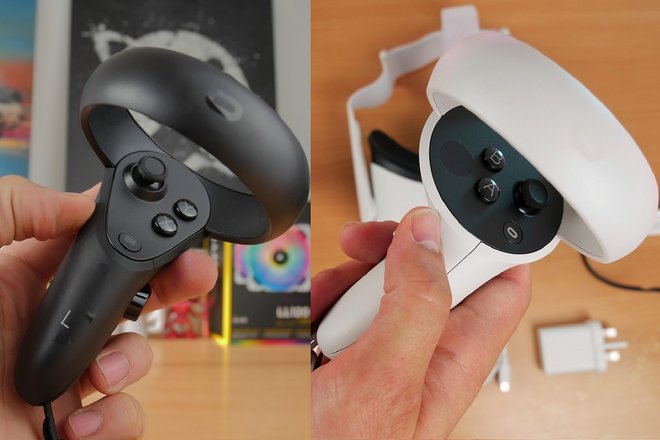
Controllers and battery life
- Improved battery life
The controllers for Quest 2 have had some slight design changes. The new design is inspired by a mix of the original controllers and those on the Oculus Rift S. You’ll note a familiar shape and style, but the Quest 2 controllers have a slightly larger space at the top with more room for your thumb to move about and access the buttons and thumbstick.
Both controllers use a single AA battery, but the Quest 2 controllers have been redesigned with less internal tracking LEDs to improve battery life. Oculus claims this means the Quest 2 controllers work four times longer than the original Quest controllers, without compromise of tracking capabilities.
The Quest 2 also has numerous intelligent battery management systems in place to maximise battery life both in the headset and the controllers. This includes settings to send the Quest 2 to sleep when it’s not in use and a nifty system which automatically turns controllers on when you put the headset on and pick them up.
Still, like the Quest, the Quest 2 can only manage between two and three hours of use before it needs charging. Both headsets are charged via a USB-C cable and the Quest 2 can reach full charge in around 2.5 hours.
Conclusion
We thought a lot of the Oculus Quest when we first reviewed it and we have a lot of good things to say about the Oculus Quest 2 for similar reasons. Both headsets are surprisingly capable considering they don’t need a PC to run, with impressive tracking, excellent visuals and a great line-up of games to play too.
Quest 2 features some nice enhancements in terms of visuals, power under the hood and a stylish design too. If you already own a Quest, you might find the changes aren’t quite enough to warrant the upgrade.
If you’re new to VR then the Quest 2 is a no-brainer though. It’s more affordable than the Quest was when it launched and offers a fantastic experience complete with hand tracking, wire-free VR gaming, superb visuals and much more besides. With recent software updates it’s just got better and better.
